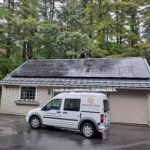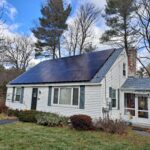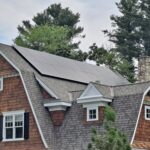I meet a lot of people who think they can’t solve the energy problem going on in the world. They believe it’s up to the government and the utilities to figure that out. Even if these same people support renewable energy, they still think they can’t make a difference. What will my 12 solar panels really do compared to the massive wind project in Cape Cod or the utility-scale solar farm proposed for Greenfield, Massachusetts? They are wrong. It’s up to all of us to solve the energy crisis. One of the reasons why we became a residential and commercial solar installer is because we are passionate that distributed generation makes sense.
There is a huge push for renewable energy in the United States right now because more than half of the states in the United States have escalated their renewable portfolio standards. The Renewable Portfolio Standard, or RPS, is the energy mix that is received from renewable sources. For example, Massachusetts has an RPS of 15% by 2020, Connecticut has an RPS of 20% by 2020, and Rhode Island has an RPS of 16% by 2019. In order to reach these goals, there are both federal and state incentives. Right now, big utilities are pushing to get all of these incentives to subsidize the cost of multi-billion dollar photovoltaic, solar thermal, and wind projects. If this happens, then aren’t we letting the same people who were in charge of the old energy world be in charge of the new one?
Now, let’s go back to the these utility-scale renewable energy projects and take a deeper look. Where are most of these projects? Since they need millions of acres of land, don’t they have to be in rural areas? That means that huge oversized transmission lines, costing up to $10 million a mile, have to connect these energy “farms” to places where there are homes and businesses. These lines are oversized because there is a tremendous amount of electricity loss, up to 10%, during transmission. The other problem with these projects is that they have to go through a multi-year evaluation process which means no one will benefit from the power they generate for several years.
I’m sure a lot of people don’t understand the concept of a microgrid. It’s pretty simple. It is best explained as small-scale electricity generation for a specific geographic location — it could be solar panels on your roof or a wind turbine in your backyard. You would be your own power plant. There would be very little transmission loss because the electricity doesn’t have to travel far. A small wind or solar project can also start almost immediately and you wouldn’t be backlogged in an evaluation process. Best of all, the profits from energy generation aren’t going to the utilities, the savings are passed along to homeowners and business. Have I convinced you yet that everyone of us as individuals have the “power” to change the world? I hope so.








Pingback: Microgrid Generation is the Solution to the Energy Crisis | Green Products - Alternative Energy
MA Solar Installer,
Thanks for your comment on my blog post (http://environment.yale.edu/blog/2010/06/30/the-massachusetts-utility-scale-solar-market-starts-moving/), and for pointing me to this post. I agree with most of what you say above, though I have a few points that I think are important:
1. Massachusetts circumvents the transmission upgrade issue for “utility scale” projects by limiting project size to 2MW. This can easily be handled by the distribution network.
2. Concerns about use of rural landscapes is valid, but I think you’ll see most of the utility scale projects in MA happening on land that has otherwise been “used and abused,” like landfills.
3. Larger-scale projects require lots of panels, which increases manufacturing capacity, which lowers prices. That’s good for the entire solar industry.
4. “Small wind” is a terrible investment for 99% of locations. Just check out the performance data on the Vermont small wind site (http://www.vtwindprogram.org/). I think only one of these projects will ever pay back enough money to the owners. The wind resource is even worse in most of CT and MA.
5. The cost for power goes down as project size goes up, with residential rooftop and carports being by far the most expensive. That said, I believe that ultimately residential, commercial and utility solar projects will all have a place in our energy mix.
6. Finally, we should accept the fact that individuals “keep the profits” from power generation because other tax payers pay for them to install their system. All renewable projects are subsidized, but the larger solar projects will help move us away from that reliance on subsidies by bringing down prices.
Again, thanks for the comment on my post. I should be adding something again soon.
Brian
Your article helped me a lot, is there any more related content? Thanks!
Can you be more specific about the content of your article? After reading it, I still have some doubts. Hope you can help me.
Your article helped me a lot, is there any more related content? Thanks!
Your article helped me a lot, is there any more related content? Thanks!
Thanks for sharing. I read many of your blog posts, cool, your blog is very good.
Thanks for sharing. I read many of your blog posts, cool, your blog is very good.
Thank you for your sharing. I am worried that I lack creative ideas. It is your article that makes me full of hope. Thank you. But, I have a question, can you help me?